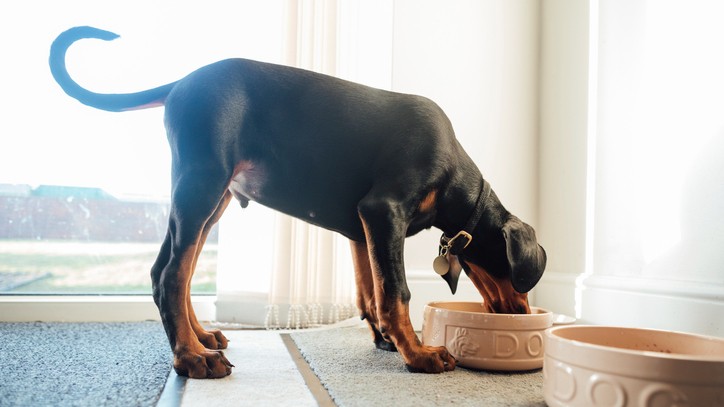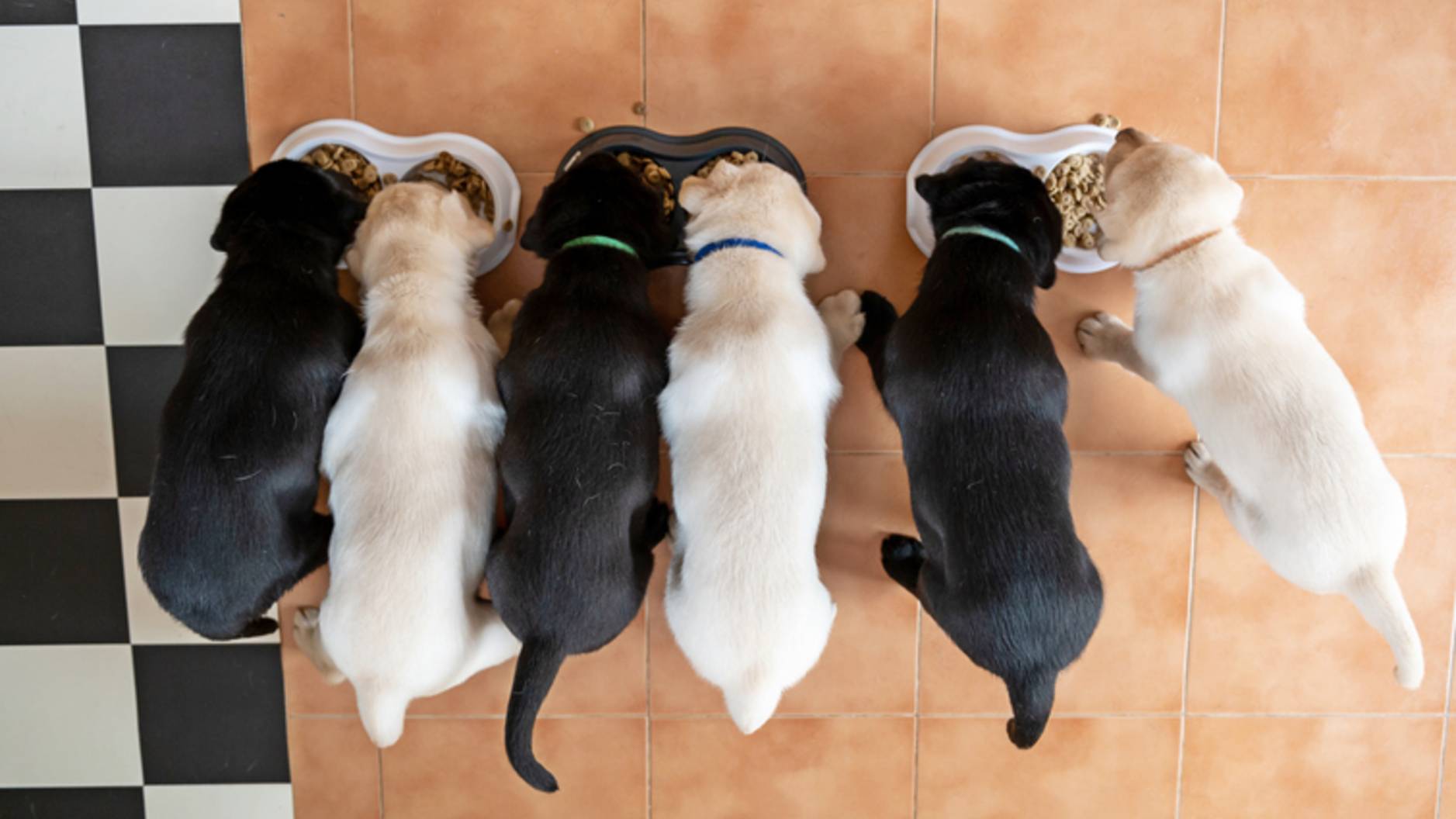How much should I feed my puppy? A vet answers...
When asking "How much should I feed my puppy?" Consider these six factors...

"How much should I feed my puppy?" is an important question to ask. After all, your puppy is growing like a weed and that means good nutrition is especially important. You want to feed your puppy the right amount for optimal growth and wellness. Feeding your puppy too much of even the best puppy food can cause rapid growth and excessive weight gain, leading to orthopedic issues and other health problems. On the other hand, feeding your puppy too little may deprive him of the essential nutrients his growing body needs. So how do you find the proper balance? Consider using these guidelines to help you find the ideal amount to feed your puppy daily.
- How to choose puppy food: Our vet offers some advice
- When should I stop feeding my dog puppy food? A vet answers
- Puppy not eating? Try this…
Start with the right puppy food
Puppies are growing rapidly, and that means the need more calories and an appropriate balance of vitamins and minerals for optimal growth. That’s why puppies should always be fed a diet that is specifically formulated for puppies until they are fully grown, which for most breeds occurs around a year of age. Large breed puppies have their own unique nutrient requirements. Large breed puppies should eat a diet specifically formulated for large breed puppies until 12-18 months of age. To find out whether your puppy food is formulated for your puppy’s life stage and size, look on the back of the bag for the AAFCO statement.
This statement should say something like “meets AAFCO guidelines for growth” or “formulated for growing puppies”. For large breed diets, look for a statement that includes large breeds, such as “formulated to support the growth of large breed puppies”. If your AAFCO statement doesn’t mention growth or puppies, it may not be appropriate for your dog’s current life stage. This means it may be necessary to switch your dog to a better puppy food. Ask your veterinarian to take a look and recommend a more appropriate diet if necessary.

Understand your puppy's weight and body condition score
Every puppy is different, even puppies from the same breed or litter. Your puppy’s ideal weight depends largely on the size of his frame, which is why veterinarians also use a subjective measure called a body condition score. To understand this concept, think about a person weighing 150 pounds. Without knowing any other information about them – such as their height, gender, or how muscular they are – you really can’t tell whether or not this is a healthy weight for that person. A body condition score helps describe whether your dog is underweight, ideal, or overweight by taking these factors into account. A body condition score is usually ranked on a scale from 1 to 9, with 1 being emaciated and 9 being obese. An ideal body condition score for your dog is usually ranked at 4 or 5.
To help you determine how much to feed your dog, ask your veterinarian about your dog’s weight and body condition score at your next visit. Your veterinarian will assess your dog’s body condition by feeling the fat deposits over the ribs, spine, and hips. If your dog’s body condition score is too low (1-3 out of 9) then you may need to increase your dog’s food intake. If your dog’s body condition score is too high (6-9 out of 9) then you may need to cut back on how much you are feeding to help him maintain a healthy weight. Your veterinarian can also use this information to calculate your dog’s recommended daily calorie intake, which you can then use to determine exactly how much to feed your puppy.
Check your dog food bag for guidelines
A feeding recommendation guide is included right on the label of most commercial dog foods. This is normally found on the back of the bag, next to the nutritional data. The feeding chart will advise you how much food to feed your puppy based on his or her present weight. However, because each puppy is unique, you may need to make some alterations to your puppy’s food intake to match his or her specific dietary requirements.
For a more precise estimate of how much to feed your puppy, ask your veterinarian to determine your dog’s recommended daily calorie intake. This will tell you how many calories your dog needs to ingest every day. You may then look up the number of calories in a serving of food by checking the back of your dog food bag or can. Don’t forget to factor in all of the other foods your puppy eats as well, like treats, table scraps, supplements, and chews. These all count towards your puppy’s daily calorie total!
Get the best advice, tips and top tech for your beloved Pets

Avoid free-feeding and provide plenty of mental stimulation
Have you ever been bored at home and found yourself wandering to the fridge for a snack just for something to do? Your dog is likely to do the exact same thing if left to his own devices and this can lead to him consuming a lot more calories than you realize! While some rare dogs are natural grazers and have no problem regulating their own intake, most dogs will happily eat more than necessary if given free access to food. For most dogs, it’s best not to leave a big bowl of food out all day. Instead, feeding carefully portioned meals two or three times a day will ensure your puppy gets the right amount of food without overdoing it.
In addition to restricting your dog’s access to food, providing them with plenty of exercise and mental stimulation will also help curb his urge to snack and seek out food during the day. Just as boredom can lead to overeating in humans, boredom can make your dog come begging for food as well! Make sure your dog gets plenty of exercise and active play time with you during the day to keep boredom at bay and perhaps learn to play some indoor games for dogs when the weather is bad. Slow feeder bowls and dog feeding puzzles are another great option to keep your dog occupied and make mealtimes last a little longer. You can also hide bits of your dog’s kibble around the house for him to find, or use meal times as a training session and make him work for each piece. He’ll still get his required daily calories, but it will be a lot more fun!

Be careful with treats
We love to give our puppies the best puppy treats and they can play a crucial role in the training process! Unfortunately, all those small nibbles can add up quickly and really pack on the pounds! When deciding how much to feed your puppy, make sure to account for his or her daily treat intake. As a rule, treats should make up no more than 10% of your puppy’s daily calorie intake. If your dog likes fresh fruits and vegetables, try switching to these lower-calorie alternatives. You can also split treats into tiny pieces or use pieces of your puppy’s regular kibble as treats to reduce his or her calorie intake.
How much to feed a puppy
As you can see, there are a lot of factors to consider when it comes to how much to feed your puppy. In general, your puppy should eat three meals a day until he is over 6 months of age. Small or toy breed puppies may need additional meals, particularly if they have had episodes of hypoglycemia, or low blood sugar. When it comes it how much to feed per meal, you’ll need to find out your pup’s daily calorie requirement. This is something your veterinarian can help you with.
Once you know your pup’s daily calorie requirement, look on the back of your pet food bag or can to find out how many calories there are per cup of dry food or per can of wet food. You can then use this information to decide how best to portion your puppy’s meals in order to meet his daily calorie requirements. Don’t forget to take any other food, treats, table scraps, etc into account as well! These little extras should make up no more than 10% of your dog’s daily calories, with the other 90% coming from a healthy, balanced puppy food.
There's no one-size-fits-all solution
No two dogs are exactly alike. How much to feed your puppy depends on several individual factors, including your puppy’s current weight and body condition score, activity level, and the type of food you’re feeding. With these tips and your veterinarian’s guidance, you can make sure that you are feeding your puppy the right amount of food to support optimal growth, nutrition, and of course, all of that puppy energy!
Dr. Elizabeth Racine is a small animal general practice vet covering all things pet health and wellness. Her special interests include veterinary behavior, nutrition, and internal medicine.
As a freelance writer, Dr. Racine has written content for major companies in the industry such as the American Kennel Club, Merck Animal Health, Bayer PetBasics, Elanco, and CareCredit. In her free time, Dr. Racine enjoys playing trampoline dodgeball, hiking with her beagle Dasher, and spending time with her three mischievous cats.

